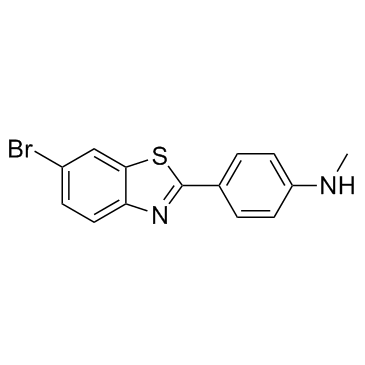4-(6-Bromo-2-benzothiazolyl)-N-methylbenzenamine |
| Katalog-Nr.GC30952 |
4-(6-Brom-2-benzothiazolyl)-N-methylbenzolamin ist ein wirksames Amyloid-Bildgebungsmittel, das an Amyloid-β (1-40) mit einer KD von 1,7 nM bindet.
Products are for research use only. Not for human use. We do not sell to patients.

Cas No.: 566169-98-0
Sample solution is provided at 25 µL, 10mM.
4-(6-Bromo-2-benzothiazolyl)-N-methylbenzenamine is a potent amyloid imaging agent which binds to Amyloid-β (1-40) with a KD of 1.7 nM.
Alzhermer's Disease (AD) is a neurodegenerative illness characterized by memory loss and other cognitive deficits. The ability to quantify amyloid load before treatment is critical to the efficient development of this class of drugs[2]. Brain entry in control mice and baboons is high for 4-(6-Bromo-2-benzothiazolyl)-N-methylbenzenamine. Staining of AD frontal cortex tissue sections with 4-(6-Bromo-2-benzothiazolyl)-N-methylbenzenamine indicates the selective binding of the compound to amyloid plaques and cerebrovascular amyloid. The encouraging properties of the compound support the choice of this derivative for further evaluation in human subject studies of brain Amyloid-βdeposition. The brain radioactivity concentrations (%ID-kg/g) of 4-(6-Bromo-2-benzothiazolyl)-N-methylbenzenamine is remarkably similar in mice and baboons (0.21 vs 0.27). The rate of clearance of radioactivity is considerably slower from baboon brain than from mouse brain, although the rank order of clearance rate is similar in mice and baboons. The tissue staining findings utilizing nonradiolabeled, fluorescent 4-(6-Bromo-2-benzothiazolyl)-N-methylbenzenamine are similar to those reported for BTA-1. Both amyloid plaques and cerebrovascular amyloid are stained by 4-(6-Bromo-2-benzothiazolyl)-N-methylbenzenamine in a manner similar to serial sections stained with an antibody to Amyloid-β, and relatively little tissue background staining is observed[1].
[1]. Mathis CA, et al. Synthesis and evaluation of 11C-labeled 6-substituted 2-arylbenzothiazoles as amyloid imaging agents. J Med Chem. 2003 Jun 19;46(13):2740-54. [2]. Klunk W, et al. Amyloid imaging as a surrogate marker for efficacy of anti-amyloid therapies.
Average Rating: 5 (Based on Reviews and 34 reference(s) in Google Scholar.)
GLPBIO products are for RESEARCH USE ONLY. Please make sure your review or question is research based.
Required fields are marked with *




















